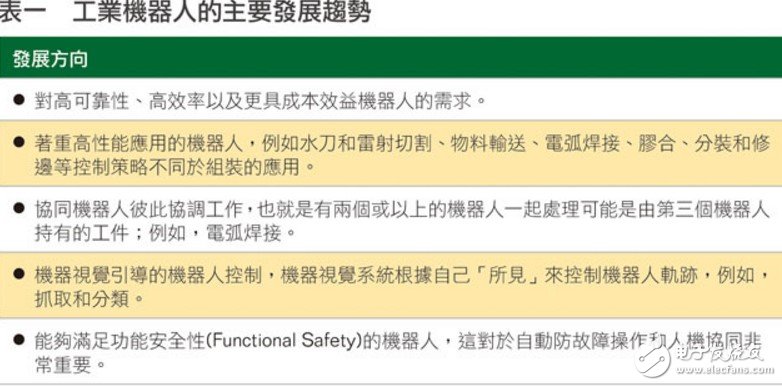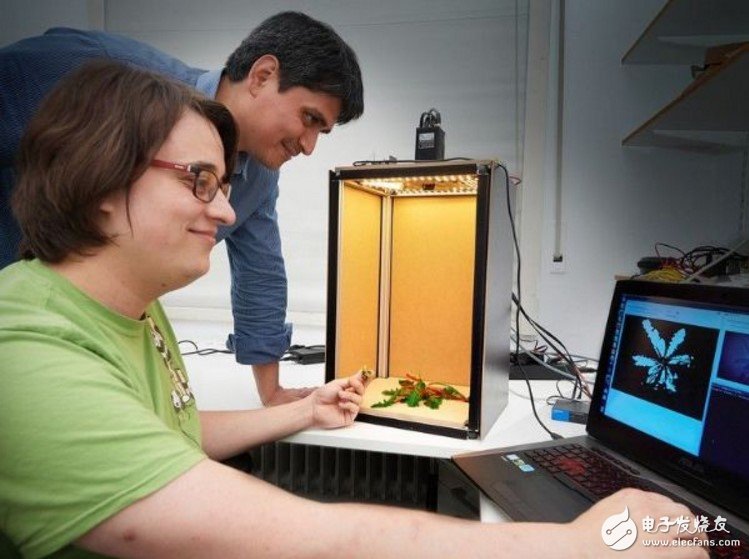Industrial robots, in terms of hardware structure, the main components are the robot's motor-driven robotic arms and joints. However, the requirements for robots are getting higher and higher (Table 1), so not only have the arm, but the robot must also have the mind and eyes. Or both feet, this involves robot perception, operation, communication and action technology, and even artificial intelligence.

When it comes to the brain of a robot, of course, we must talk about artificial intelligence. Overall, the robot is advancing with the times, not only the upgrade of the machine tool or component hardware, but also the breakthrough of analysis technology, so that the robot has higher intelligence. Due to the high development threshold of artificial intelligence, the main investors in the market are heavyweight technology manufacturers. These companies have also launched related artificial intelligence platforms, such as AlphaGo platform developed by Google's DeepMind, Intel's Nervana platform, etc. .
Among them, AlphaGo, which is famous for its Go game, is based on the deep learning of neural networks for estimation, prediction and decision making. When applied to industrial robots, robots can use machine learning to detect workpieces and automatically sort them according to the ease of picking up. This is an evolution of industrial robots with deep learning ability, and this is just one example.

Let's take a look at the sensory part of the robot. This is mainly to give the robot the "sensory" function through the sensor. For example, "vision" is the common sense of industrial robots. This is because electronic parts are getting smaller and smaller, and the human eye is no longer capable of accurate assembly and inspection. Therefore, machine vision with high-precision detection features has become the standard equipment for many mission robots. , widely used in measurement, positioning, guidance, identification and so on. The Insight Partners research report pointed out that the output value of machine vision system components and system integration will grow from $7.5 billion in 2015 to $14.48 billion in 2025.
The machine vision system mainly uses optical devices and software algorithms to simulate human recognition and judgment of the three-dimensional world. The system hardware consists of image processor, image capture card, sensor, programmable logic controller, camera, illumination source, etc. The software technology uses image processing, signal conversion and 3D object recognition algorithms. The laser weeding robot developed by the University of Bonn in Germany has a photographic identification system, which, like the eyes of farmers, can accurately identify the grass phase in the field; after computer operation, it is equipped with a laser device, and then irradiates the weed with laser light. After the plants, the stems become weak and the growth is blocked, and finally they die.
Many manufacturers in Taiwan have been involved in the field of machine vision. For example, Solomon's self-developed 3D vision module allows the robot to identify the workpiece in a messy working environment and classify the workpiece according to the type, shape and size of the workpiece. Place items after the object. Advantech's EagleEye machine vision solution assists manufacturers in solving online quality control and bar code interpretation through smart cameras equipped with embedded image processing software, while also providing machine vision positioning guidance. Auxiliary robot arm for workpiece clamping.
Have a painful feeling that the robot protects itselfIn addition, in order to avoid extensive damage to industrial robots, robots with "pain" have appeared. German scientists Johannes Kuehn and Sami Haddadin recently published the results of this research at the IEEE International Conference on Robotics and Automation (ICRA), a painful robotic arm developed on the basis of human skin structure, which has "neural machine organization ( "angry robot-TIssue)" is given the pain.
The team report pointed out that when the robot senses a slight pain, it will automatically retreat slowly until it returns to its original position without contact with the original "uncomfortable" item; when it feels moderate pain, the robot will quickly recover and with the item Keep the proper distance and finally return to the original position; when it feels severe pain, it will recognize that such contact may cause its own injury, and need the assistance of others, the robot arm will change into passive mode, The damage is reduced to a minimum.
Intelligent manufacturing and robots, the progress of sensing technology such as the Great Leap Forward machine vision, the main thrust comes from intelligent manufacturing. In fact, from point to line to face, the trend of intelligent manufacturing brings the influence of the robot industry to a comprehensive level, for example, machinery. Arms will generally have machine learning capabilities; thanks to control technology, and circuit design that prevents mutual interference between robots, the density of robots on-line production is improved; and all robots are in big data through digitization of production information. Under the blessing, it will be able to have more flexibility.
However, the development of industrial robots also has its challenges. Zian is also a problem that industry must pay attention to, especially for reasons of efficiency, accuracy and safety. Industrial robots have already replaced manpower in many large-scale production lines. If they are subjected to malicious attacks, they may lose not only property but even human life. Therefore, as we continue to chase the functions and productivity of industrial robots, we should also pay attention to whether robots can withstand cyber attacks.
2.0mm (0.079") Pitch Female Headers
Overview
2.00 mm pitch female sockets/headers are low-profile connectors designed for signal and low power PC board connections when space is at a premium. Options include through-hole, surface mount and can be customized for mixed technology, press-fit and pass-through terminations. The pins and blades are available in various sizes, counts, amperages, and plating.
The 2.0mm pitch female headers are commonly found in PC`s and are also made to work in Arduino boards, Arduino Pro and Arduino Mega with either single or double-row female headers, facilitating connections for programming and incorporation into other circuits. They have the perfect height for clearing the USB-B connector and great for stacking multiple shields.
Female header always called as [Header connector", Antenk provide widely range of header connector, from 2.54mm (.100″ inch) pitch to 1.0mm (.039″ inch) pitch. The number of pins (contacts) is from 2 to 40 pins per orw. There are three type: Straight (Dip Vertical), Right angle, SMT (surface mount).
If you can not find the items you interest from above items, welcome to contact us, and you will always get fully responsive from us.
Applications of 2.0mm Pitch Female Headers
Electronics:
LED applications
Arduino boards
Solar applications
Weighing systems
Appliances:
Air conditioner
Refrigerator
Microwave oven
Washing machine
Water heater
Shower toilet
Washer/Dryer
Stove
Automotive, Heavy Duty Military and Marine
For densely packed equipment requiring weight reduction and downsizing and for tough and harsh conditions.
Vehicle infotainment
Computer peripherals
Battery Connections
Battery connections rely on the ability of the current to pass reliable and solid current. This prevents overheating in the circuit and voltage drop.
Rechargeable battery packs
Battery balancers
Battery eliminator circuits
Medical Diagnostic and Monitoring equipment
Heart monitors
Communications
TelecomsDatacoms
Mount Type: Through-hole vs Surface Mount
At one side of this female header is a series of pins which can either be mounted and soldered directly onto the surface of the PCB (SMT) or placed into drilled holes on the PCB (THM).
Through-Hole (Poke-In)
Best used for high-reliability products that require stronger connections between layers.
Aerospace and military products are most likely to require this type of mounting as these products experience extreme accelerations, collisions, or high temperatures.
Useful in test and prototyping applications that sometimes require manual adjustments and replacements.
2.0mm vertical single row female header, 2.0mm vertical dual row female header, 2.0mm right-angle single row female header and 2.0mm right-angle dual row female header are some examples of Antenk products with through-hole mount type.
Surface-Mount
The most common electronic hardware requirements are SMT.
Essential in PCB design and manufacturing, having improved the quality and performance of PCBs overall.
Cost of processing and handling is reduced.
SMT components can be mounted on both side of the board.
Ability to fit a high number of small components on a PCB has allowed for much denser, higher performing, and smaller PCBs.
2.0mm Right-angle Dual Row female header, 2.0mm SMT Single row female header and 2.0mm SMT Dual row female header are Antenk`s SMT female headers.
Soldering Temperature for 2.0mm Pitch Female Headers
Soldering SMT female connectors can be done at a maximum peak temperature of 260°C for maximum 60 seconds.
Orientation/Pin-Type: Vertical (Straight) and Right-Angle
2.0mm pitch female headers may be further classified into pin orientation as well, such as vertical or straight male header or right-angle female header.
Vertical or Straight Female Header Orientation
One side of the series of pins is connected to PCB board in which the pins can be at a right-angle to the PCB surface (usually called "straight" or [vertical") or.
Right-Angle Female Header Orientation
Parallel to the board's surface (referred to as "right-angle" pins).
Each of these pin-types have different applications that fit with their specific configuration.
PCB Connector Stacking
For 2.0mm pitch female headers, the orientation is either offered as vertical or right-angle, which are options. Elevated sockets/female headers can be available upon request.
Profile Above PCB
This type of configuration is the most common way of connecting board-to-board by a connector. First, the stacking height is calculated from one board to another and measured from the printed circuit board face to its highest insulator point above the PCB.
Elevated Sockets/Female Headers
Elevated Sockets aka Stacked sockets/receptacles or Mezzanine are simply stacked female headers providing an exact distance requirement between PCBs that optimizes electrical reliability and performance between PCB boards.
Choosing this type of stacking configuration promotes the following benefits:
Connector Isolation - the contacts are shrouded preventing cable connection mishaps and good guidance for the mating header connectors.
For off-the-shelf wireless PCB module, stacking height is optimized with elevated sockets.
Offers superior strength and rigidity.
Polarisation prevents users from inverted insertion.
Single, Dual or Multiple Number of Rows
For a 2.0mm straight or vertical female header, the standard number of rows that Antenk offers ranges from 1 to 2 rows. However, customization can be available if 3, 4 or n number of rows is needed by the customer. Also, the number of contacts for the single row is about 2-40 pins while for dual row, the number contacts may vary from 2-80 pins.
Pin Material
The pins of the connector attached to the board have been designed with copper alloy. With customer`s demand the pins can be made gold plated.
Custom 2.0mm Pitch Female Headers
Customizable 2.0 mm pitch female headers are also available, making your manufacturing process way faster as the pins are already inserted in the headers, insulator height is made at the right size and the accurate pin length you require is followed.
Parts are made using semi-automated manufacturing processes that ensure both precision and delicacy in handling the headers before packaging on tape and reel.
Tape and Reel Packaging for SMT Components
Antenk's SMT headers are offered with customizable mating pin lengths, in which each series has multiple number of of circuits, summing up to a thousand individual part number combinations per connector series.
The tape and reel carrier strip ensures that the headers are packaged within accurately sized cavities for its height, width and depth, securing the headers from the environment and maintaining consistent position during transportation.
Antenk also offer a range of custom Tape and reel carrier strip packaging cavities.
2 Pin Header,2.0Mm Female Pin Header,2.0Mm Pcb Connector,2.0 Pcb Header,0.079" Pitch Female Headers,2.0mm Female Pin Header SMT, 2.0mm Female Pin Header THT
ShenZhen Antenk Electronics Co,Ltd , https://www.pcbsocket.com